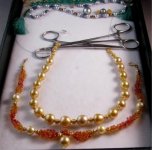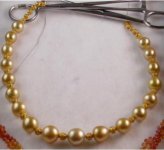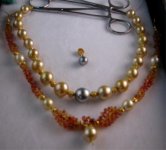claudenancy
Well-known member
- Joined
- Jul 2, 2008
- Messages
- 246
I am so grateful for all I have learned here. I need some suggestions for a necklace that I about to string. I am not at all sure what my best option for stringing material might be.
This is my version of an add a pearl necklace. I have been hoarding special Indonesian gold pearls. Most of these came from a beautiful bracelet that my husband gave my for our 30th anniversary--purchased from C. Ehret. Others also came from her, and most are from the same harvest that she purchased directly from the farm. I soon realized that I loved the bracelet, but do not wear bracelets well or comfortably. I now want to put all of the pearls together with gold beads. I have just enough now to make a choker but might add more later. I am especially interested in acquiring one special large central pearl to extend the necklace at some point, so restringing might (or might not) be the future of this necklace. Several sources are watching their incoming lots for an appropriate central pearl.
I plan to knot between the pearls, and hope that the gold beads can cover the knot. Do you think I could use powerpro for this necklace, or would you advise staying with silk? I seem to recall that there was some hesitation to use powerpro with the larger SS pearls, but I cannot find the comment.
Any other thoughts or suggestions?
Thanks, Beth
This is my version of an add a pearl necklace. I have been hoarding special Indonesian gold pearls. Most of these came from a beautiful bracelet that my husband gave my for our 30th anniversary--purchased from C. Ehret. Others also came from her, and most are from the same harvest that she purchased directly from the farm. I soon realized that I loved the bracelet, but do not wear bracelets well or comfortably. I now want to put all of the pearls together with gold beads. I have just enough now to make a choker but might add more later. I am especially interested in acquiring one special large central pearl to extend the necklace at some point, so restringing might (or might not) be the future of this necklace. Several sources are watching their incoming lots for an appropriate central pearl.
I plan to knot between the pearls, and hope that the gold beads can cover the knot. Do you think I could use powerpro for this necklace, or would you advise staying with silk? I seem to recall that there was some hesitation to use powerpro with the larger SS pearls, but I cannot find the comment.
Any other thoughts or suggestions?
Thanks, Beth



